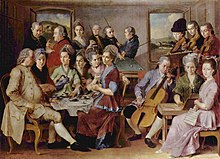Wilhelm Remy
Wilhelm Remy (* 1702 in Grenzhausen ; † July 1, 1761 in Bendorf ) was a German businessman and mining entrepreneur .
Life
Wilhelm Remy learned the trade from his childless uncle (1662–1729) in Vallendar . In 1725 Remy moved to Bendorf and leased the Steinbrück hammer hut there , which he successfully ran.
On August 8, 1729, Remy was appointed court factor by Duke Wilhelm Heinrich of Saxony-Eisenach , an award for meritorious merchants. His uncle, who died on January 22, 1729, left him a considerable inheritance. During this time, the Bendorfer Hüttenwerk, the Untere Hütte, with the associated mine "Vier winds", owned by the Bendorfer merchants Wirthsen, Bertram and Grün, was up for sale. Remy bought a quarter of the hut, the rest went to the St. Thomas Abbey in Andernach . He leased this share and thus became the sole owner of the hut. Now he could smelt ore and process pig iron himself or sell it to the nearby hammer mills . It was said of his iron that horseshoes made from it lasted four times longer than the previously used ones. In 1731/1733 Remy also became a silent partner in the Wendender Hütte.
In order not to be dependent on only one ore mine, Remy bought the Sauwasen mine in County Diez and also forests for the production of the charcoal required for ore smelting . He supplied the Bergische steel works with pig iron ingots and shipped his goods to the Rhine , Main , Mosel and Neckar . He delivered cannonballs to the Rotterdam company of his brother-in-law Hoffmann & Hartcop . The quality of the Bendorfer pig iron and the finished products exceeded that of the Siegen smelters and was also better than the Swedish products.
In 1741 Remy founded his own trading firm Wilhelm Remy & Cie. , in which he took his cousin and brother-in-law Johannes Remy (1713–1778) as a partner two years later. After the great Bendorfer fire in 1743, he led the reconstruction of the place with the bailiff Johann Anton Rhodius. In 1744 Remys was appointed to the Brandenburg-Ansbach Chamber of Commerce . In 1747 he had a large house built for himself, called "at the Entenbach-Hof", which was painted by the court painter Januarius Zick from the Electorate of Trier . In 1752 Remy finally acquired the shares of the noble fräuleinstift St. Thomas in the Bendorfer Hüttenwerk Untere Hütte and became their sole owner.
Wilhelm Remy died on July 1, 1761 and was buried in the choir of the Bendorfer Church. After his death, his widow ran the company together with Johannes Remy and Albert Wilhelm Hoffmann under the name Wilhelm Remy seel. Erben & Co. continue.
meaning
Wilhelm Remy was in the Neuwied area what later was Alfred Krupp in the Ruhr . The former steelworks locations on the Rhine and Moselle can be seen as the " Ruhr area " of the Middle Rhine. The investments made by Remy transformed Bendorf from a farming village into an industrial location. With his fortune, Remy created the material basis for all later successful businesses of the Remy family.
family
Wilhelm Remy came from a French family who emigrated to Germany for reasons of faith in 1586. In 1728 he married Elisabeth Maria (1711–1771), the daughter of the Hachenburg city councilor Johann Philipp Hoffmann, who had good connections with the Dutch trading company Hartcop. Wilhelm Remy and his wife remained childless. A relative of Wilhelm Remys, Heinrich Wilhelm Remy (1733–1779), leased the ironworks Rasselstein in Neuwied in 1760 , which was bought in 1784 by his brother-in-law Carl Wilhelm Remy (1747–1817).
Honors
The Remystrasse in Bendorf and, since 1989, the Bendorfer Gymnasium are named after Wilhelm Remy .
swell
- Ironworks in Bendorf, writings from the Bendorf City Museum
literature
- 150 years of existence of the Rasselsteiner Eisenwerk Gesellschaft, 1910
- The Remys. Ironworkers with body and soul. Ed .: Museumsverein Wendener Hütte eVu City Administration Bendorf. Authors: Ulrike Hoppe-Oehl, Monika Löcken, Adelheid Simon-Schlagberger. - Weneden, Bendorf 1998 (= writings of the museum association Wendener Hütte eV, vol. 2; writings of the city museum Bendorf, vol. 7). ISBN 3-930271-64-8 .
- Ilse Müller / Günther Schweizer / Peter Werth: “The Remy family - Kannebäcker and entrepreneur. A genealogical inventory ”, LEGAT-Verlag, Tübingen 2009, ISBN 978-3-932942-36-5 .
Web links
- The hut owners Remy and Hoffmann
- Entry on Wilhelm Remy in the Rhineland-Palatinate personal database
Individual evidence
- ↑ 150 YEARS • EXISTENCE of Rasselsteiner Eisenwerk Gesellschaft, Rasselstein bei Neuwied, memorandum, In memory of the hundred and fifty years of association between the Rasselsteiner Eisenwerk and the Remy family (1760–1910). In: dilibri.de. 1910, Retrieved February 12, 2019 .
| personal data | |
|---|---|
| SURNAME | Remy, Wilhelm |
| BRIEF DESCRIPTION | German businessman and mining entrepreneur |
| DATE OF BIRTH | 1702 |
| PLACE OF BIRTH | Grenzhausen |
| DATE OF DEATH | July 1, 1761 |
| Place of death | Bendorf |

